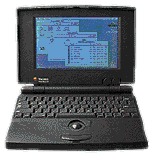It seems rather odd writing about the PowerBook 100 on my PowerBook G4. One is the
smallest PowerBook I've ever  used, the
other is the thinnest PowerBook ever. Neither has an internal floppy
drive.
used, the
other is the thinnest PowerBook ever. Neither has an internal floppy
drive.
Until about a week ago, I'd never seen or touched a PowerBook 100.
I'd heard it was a real sweetheart of a laptop: compact, light, and
fast enough to be a good writing machine. Thanks to Kyle Hansen, I now
own one.
Taking the tiny PB 100 out of the shipping box, I was blown away by
the small footprint. This computer is just 11" wide and 8.5" deep. (For
those keeping score, that's 2" narrower and an inch less deep than my
TiBook.) It also seemed remarkably light - it turns out that it weighs
about 3 ounces less than my TiBook.
Battery Problems
I put the little guy on the dining room table, plugged in the AC
adapter, and hoped for the best. Alas, the battery is completely shot.
Fortunately BTI makes a NiMH battery for the PB 100; unfortunately it
costs $89.
Then I remembered a pair of articles Manuel Mejia Jr wrote for Mac
Daniel last year: The carpenter's trade
in the computer age and Field
Testing the Carpenter's PB 100 Fix. Definitely something to look
into.
Next I visited the PowerBook 100 FAQ to read up on
batteries, recommended software, and lots more. There I discovered that
it may be possible to refurbish the existing battery.
That's all stuff to investigate later. I've just signed up for the
PB 100 email list. I'm sure the folks there will be able to help me
decide which way to go.
The Computer
My first impression of the PowerBook 100 was quite positive. Not
only it small and compact, but it has a good solid feel to it. Sony,
who built the PB 100 for Apple, really paid attention to the
details.
Unlike other 100-series PowerBooks, the 100 has small feet in the
back that extend as you rotate them down. Too bad one of mine is
broken, but it's a very neat feature.
The battery is long and slim, sliding in from the front of the
laptop. Very nice.
The trackball is smaller than the rest of the 100-series uses,
undoubtedly because the PB 100 is so much smaller than the other
models.
The screen, a 1-bit active matrix display, is tack sharp. The hinge
and latch seem well made, too. The PB 100 has knobs for brightness and
contrast.
The external floppy drive is cleverly designed. A hinged piece
covers the floppy slot during transport, then flips down to raise the
front of the drive when it's in use. The only problem I see with the
floppy drive is the huge plug that requires at least 3" of clearance
behind the computer. Too bad that wasn't quite a bit smaller.
The PB 100 has all the usual PowerBook ports from 1991: ADB, serial,
SCSI, and power. There's a knockout for a modem, as well as an audio
out port for a speaker or headphones. And another touch that
distinguishes the 100 from other early PowerBooks: the port cover has a
latch to keep it closed.
The Keyboard
The only place the PowerBook 100 is lacking is the keyboard. It's
about 1/2" narrower than the one on my TiBook, so it takes a bit of
getting used to the tighter spacing. With that adjustment, though, it's
a very good keyboard for typing.
The keys have a much longer action than recent PowerBooks, and they
also feel cheaper in some way, more like a toy keyboard. But they work
just fine for typing.
The big adjustment is the keyboard layout - a few keys had to be
relocated. So the command key isn't immediately to the left of the
space bar. Instead, the escape key sits there. The control and option
keys are also one space to the left of where they are on my TiBook.
To the right of the space bar is the enter key, followed by four
full-sized arrow keys. That's the old Mac Plus and compact ADB keyboard
layout, and it's not a bad choice at all.
Other than that, the keyboard matches the traditional Macintosh
layout. Pulling up MacWrite and typing was very comfortable.
Conclusion
I've often commented that for most users most of the time, a 300 MHz
G3 is plenty of power. With Apple offering nothing that slow, pretty
much everyone will be happy with the computer's speed.
Back in my Mac Plus days,
I found 8 MHz performance barely acceptable under System 6.0.x - and
downright sluggish with System 7. Having Brainstorm install a 16 MHz 68000
upgrade changed all that, making the Plus a very pleasant System 7
computer. At 16 MHz, a Mac can comfortably keep up with my typing, not
lagging behind as was common at 8 MHz.
I've used SE/30s and
Portables, both 16 MHz models
that bear this out. With MacWrite, ClarisWorks (v1-3), and MS Word
5.1a, these were all very comfortable writing machines.
The same definitely holds for the PB 100. For the basic task of
writing or taking notes, the size, weight, and speed are wonderful. It
makes you wish Apple had teamed up with Sony on other projects.
Now I just need to solve that battery problem....

 used, the
other is the thinnest PowerBook ever. Neither has an internal floppy
drive.
used, the
other is the thinnest PowerBook ever. Neither has an internal floppy
drive.
